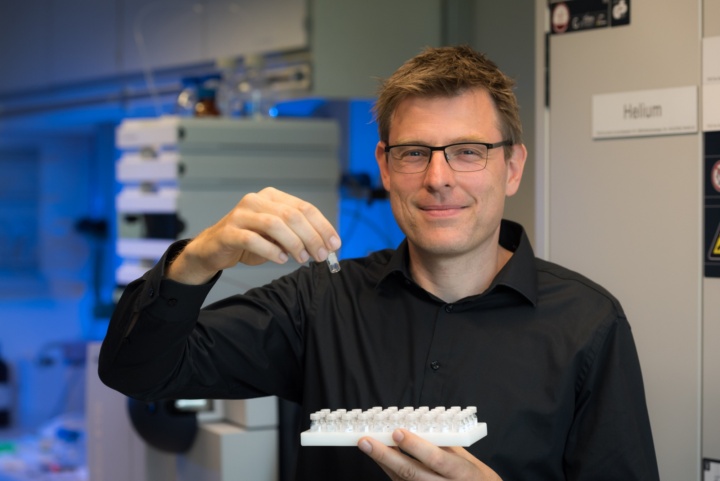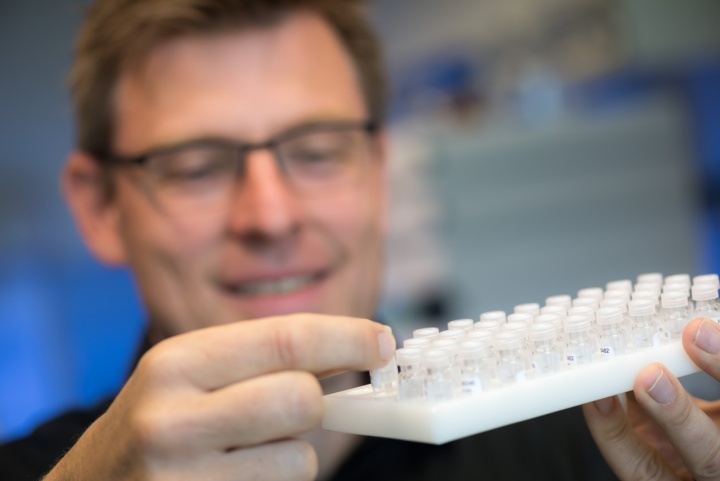People with food allergies usually have to completely avoid any contact with the food in question. Jens Brockmeyer would like to be able to identify the trigger allergens directly and to understand what makes a protein into an allergen. His primary “sniffer dog” in this undertaking is the mass spectrometer. The professor has headed up the recently created Food Chemistry Department at the University of Stuttgart's Institute of Biochemistry and Technical Biochemistry (IBTB) since 2016.
Jens Brockmeyer's main focus is on the protein pool in foods, the so-called proteomics. He sniffs out rogue substances among the food proteins that trigger an immunological reaction in food allergy sufferers. In Germany, almost one in twenty people have an allergy to at least one type of food. The most common trigger substances are milk, egg, soya, wheat, peanuts and tree nuts, fish and crustaceans. Even minute concentrations of allergens can trigger an allergic reaction in some suffers, sometimes culminating an anaphylactic shock. Others can consume a comparatively large amount until they notice the first signs of tingling or itching.
“Our current problem is that many foodstuffs are labeled with such statements as: ‘may contain traces of ...’”, says Brockmeyer angrily. Manufacturers apply this label to foods as a precautionary measure if there is any risk of accidental contamination with allergens during the manufacturing or filling processes. Whether and in what quantities the substance actually contains any allergens whatsoever remains unclear.
The exciting thing about food chemistry is that it can be used to solve tangible issues. On the other hand, trying to understand the composition of food is fascinating
Jens Brockmeyer
If allergy suffers want to ensure that they avoid triggering a reaction, they have to avoid the suspect substance completely. “That places huge restrictions on their everyday lives”, says Brockmeyer. It would be better, Brockmeyer continues, to specify the allergen concentration that is just sufficient to trigger an allergic reaction in a suffer as a threshold value for foodstuffs. The necessary clinical data has been gathered for many allergens over the past few years. Finding even minute traces of specific allergens in a given foodstuff requires highly sensitive detection methods. However, the two most common methods currently used in routine laboratories both have their weaknesses.
The immunological ELISA-tests involve fishing antibodies out of the food sample not only of the sought-after allergen but also structurally similar molecules.The second so-called Polymerase Chain Reaction (PCR) method requires food analysts not to verify the presence of the protein, which triggers the allergy, but a fragment of DNA typical of the allergenic foodstuff. However, because all of an organisms cells contain the identical DNA information, the analysts are not able to differentiate between a hens egg and a chicken. This also goes for milk and beef. “Nor would I be able to use PCR to determine whether a product contains albumen or not, because albumen contains practically no DNA”, Brockmeyer explains, “but it is full of allergens”.
Processed food cracked
In particular, the current detection methods fail against processed foods, partially, it is thought, because proteins become denatured through heating and are no longer recognized by the antibodies, or because the DNA in acidic foodstuffs, for example, decomposes long before the allergens and, therefore, escapes detection. Brockmeyer uses mass spectroscopy to detect the allergens. The devices in the adjacent laboratory are on every day around the clock. With this method, Brockmeyer's team can detect the most minute quantities of allergens, even in processed foods, for example traces of nuts in bread, chocolate and ice cream.
Mass spectroscopy involves crushing protein fragments from the food samples, which have been cut into little pieces by enzymes, so-called peptides, to charged fragments, which are then separated by charge. A peptide's mass spectrum is, as it were, its “finger print” from which its structure can be inferred. Brockmeyer and his colleagues can scan the food sample for the known peptide finger prints of various allergens simultaneously. At first, it was particularly tricky to identify those marker peptides that are specific to a single allergen from among the millions of different protein fragments from the food sample.
For example, one of Brockmeyer’s colleagues had to wash every single hazelnut with various solutions, because nuts are nearly always contaminated with traces of other nuts. Only then would she scrape a piece from the surface to analyze all the proteins it contained in the mass spectrometer and to select those marker peptides that were easiest to detect. In the meantime, the group has successfully identified the marker peptides for the most common allergens responsible for over 90 per cent of all allergic reactions. “We have to use every trick in the book to get to the sensitivity range we need with our high-resolution mass spectrometer” Brockmeyer admits. Routine laboratories, which already use less sensitive mass spectrometers to detect traces of residual pesticides and mycotoxins in food, cannot compete with this.
Bait molecules increase sensitivity
To make this method usable for normal mass spectrometers, the team is currently developing bait molecules from DNA and RNA aptamers, which fish out only the sought-after marker peptides from the millions of peptides, thus concentrating them for detection in the mass spectrometer. In addition, the group wants to automate the sample preparation process to enable the simultaneous rapid analysis of as many food samples as possible.
Brockmeyer also uses the mass spectrometer to track down counterfeit food – for the first time, without even having to know what he is searching for.Today, he would be in a position to rapidly uncover things such as the beef lasagna scandal in 2013, in which the beef was laced with cheaper horse meat, because the proportion of beef-specific peptides in the total quantity of mammalian marker peptides would be lower. If, as happened in the USA back in 2014-15, spices containing cumin have been, probably deliberately, contaminated with peanuts then the counterfeit food puts allergy sufferers in real danger.
What excites Brockmeyer about food chemistry is that it can be used to solve tangible issues. “You know why you’re analyzing a given substance”, he explains. On the other hand, he is fascinated by questions such as what food is composed of, and why certain food allergens trigger an immunological response in the small intestine, whereas structurally similar molecules are able to pass without incident. His team is currently playing through the passage of food through the digestive tract in the model system and analyzing the structure of the allergen peptides that arrive in the small intestine. It may be possible at some point to use them for a specific immune therapy for the treatment of food allergies.
Were it not for his brother, who is 13 years older than him and works as a food chemist in toxin analysis, Brockmeyer may well have chosen a different career path. “We've already agreed that we’ll do a few joint experiments using our machines here” says the younger brother happily. Right from the start, his career seemed like a vocation – even if the way there was not always straightforward.
Even at school in Osnabrück, the now 43-year-old was enthusiastic about chemistry but also about physics. After completing a vocational training course as a laboratory chemist, the pendulum swung in the direction of chemistry. But he likes to get to the bottom of things and went back to school to pocket his university-entrance diploma so that he could study. Again, he vacillated, this time between biochemistry and food chemistry before finally deciding to follow in his brother’s footsteps.
The exciting thing about Stuttgart is that collaborative projects that I never would have dreamed of are a frequent occurrence here
Jens Brockmeyer
Detective in forensic medicine
As a freshly qualified food chemistry graduate from the University of Münster, Brockmeyer first took a detour via forensic medicine in Bonn. As he tells it, he wanted to do something relevant, not just “analyzing the number of raisins in Christmas cake”. The analytical methods are the same, regardless of whether he is searching for residues in food or of drugs in blood or urine. Following a murder case involving a drug that paralyzes the muscles of respiration, he attempted to detect the substance using mass spectroscopy but came up against technical limits. His doctoral studies at the Münster University Hospital were supervised by the renowned microbiologist Helge Karch. Karch is credited with the discovery of a certain type of dangerous (EHEC) diarrhea pathogen, which had been responsible for all major outbreaks in Germany and primarily spreads via contaminated food. This time, Brockmeyer used biochemical and molecular biological tools to investigate the structure and function of an EHEC virulence factor – for which he received the German Microbiology Association Doctoral Prize.
Since then, he has always maintained contact with his “alma mater”: time and again he attended seminars at the University of Münster's Institute of Food Chemistry, where he also carried out various analyses for his doctoral thesis. Finally, he was offered the opportunity to do a post-doctoral qualification at the institute. His research on EHEC continued augmented by his current fields of research, food allergens and the authenticity of food, which he brought with him to Stuttgart along with a number of colleagues.
The fact that Brockmeyer has now settled in as the Head of Food Chemistry at the Institute of Biochemistry and Technical Biochemistry (IBTB) seems like a stroke of destiny. “The exciting thing about Stuttgart is that collaborative projects that I never would have dreamed of are a frequent occurrence here”, Brockmeyer says. His department will shortly be conducting research into whether the nutritional value and protein composition of algae change under the zero gravity, high radiation conditions of space, or if they could be used as astronaut food or for generating oxygen in future without any issues. The Institute of Aeronautics and Astronautics has already provided an algae bioreactor, which will soon be sent to the International Space Station (ISS).
Helmine Braitmaier




